on Volvo, VW, McLaren, Lambo, Buick, and more
Volvo wants to become a green vehicle manufacturer. . .VW brings a new compact SUV the Taos. . .McLaren does clever things with air. . .Lambo Countach design. . .under the VW Caddy. . .the new Buick Envision. . . .
Volvo wants to become a green vehicle manufacturer. . .VW brings a new compact SUV the Taos. . .McLaren does clever things with air. . .Lambo Countach design. . .under the VW Caddy. . .the new Buick Envision. . . .
This week On Automotive
- Volvo: Green Beyond the Vehicle
- The Taos: Of Course It Drives Like a VW
- The Interesting Option for the McLaren Elva
- Lambo Countach at 50
- A View You Otherwise Won’t Get. . .
- A Rolls Not for the Rest of Us
- 2021 Buick Envision Essence AWD
///
Volvo: Green Beyond the Vehicle
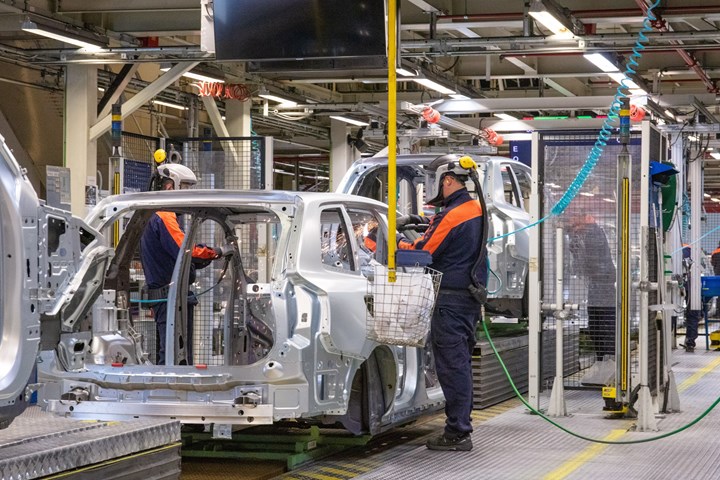
Inside Volvo Torslanda plant. (Image: Volvo)
When you think about vehicle manufacturers becoming “green,” odds are it is the vehicle part, not the manufacturing, that you think about, as in electric vehicles.
Volvo is certainly going down the road of electric vehicles.
Last March, Henrik Green, the company’s chief technology officer, said:
“There is no long-term future for cars with an internal combustion engine. We are firmly committed to becoming an electric-only car maker and the transition should happen by 2030. It will allow us to meet the expectations of our customers and be a part of the solution when it comes to fighting climate change.”
Can’t be much more clear than that.
Still, whether it is a crossover with a battery or an internal combustion engine (let’s face it, there are 8.5 years between now and 2030, so those engines aren’t going away tomorrow), it has to be manufactured.
Volvo Cars has announced that its Torslanda assembly plant is its first “climate neutral” assembly plant—its Skövde engine plant achieved that status in 2018.
On this, Javier Varela, head of industrial operations and quality at Volvo Cars, said:
“Establishing Torslanda as our first climate neutral car plant is a significant milestone. We are committed to having a climate neutral manufacturing network by 2025 and this achievement is a sign of our determination as we consistently work to reduce our impact on the environment.”
And you can’t be much more clear than that, either.
At the plant they build the XC90, XC60, V60 and V90.
///
The Taos: Of Course It Drives Like a VW

The MQB: What makes the Taos drive like a Volkswagen. (Image: VW)
Volkswagen has the Tiguan and Atlas SUVs in its lineup.
The Tiguan competes with the likes of the Honda CR-V and Toyota RAV4.
The Atlas competes with vehicles including the Chevy Traverse and Ford Explorer.
And now VW has added the Taos.
The Taos competes with the Jeep Compass and the Subaru Crosstrek.
MEB Means. . . .Here’s the remarkable bit: That image up there is the Volkswagen MQB platform.
The MQB platform is the basis for the Taos, Tiguan and Atlas.
Know that the length, wheelbase and width of the Taos are 175.8 inches, 105.9 inches and 72.5 inches.
Know that the length, wheelbase and width of the Atlas are 200.7 inches, 117.3 inches and 78.4 inches.
One of the points that VW is emphasizing about the Taos is that it “drives like a Volkswagen.”
Given the MQB platform, is that any wonder?
Jetta, too. And there is another factor: the Taos is powered by a 1.5-liter version of a turbocharged four, the EA211, which produces 158 hp and 184 lb-ft of torque. The EA211 is also used to power the Volkswagen Jetta. (Though a less-powerful version.)
Like the Tiguan and the Atlas the Taos is available as a front-wheel-drive model or with the 4Motion all-wheel-drive system. The FWD models are equipped with an eight-speed automatic. The 4Motion Taos has a seven-speed dual-clutch transmission. Perhaps not uncoincidentally, the Golf GTI is available with a seven-speed dual-clutch transmission. And it is also based on MQB.
Design, Too. There are design cues that reference other VWs. There is a strong character line (though not as strong) that brings the Tiguan to mind; there are squared-off wheel arches that are Atlas-like; and there is are lightbars in the front grille that flank the VW badge that is like the front of the ID.4.
The Taos is manufactured at the Volkswagen de Mexico plant in Puebla.
So are the Jetta and the Tiguan.
Yes, drives like a VW.
///
The Interesting Option for the McLaren Elva
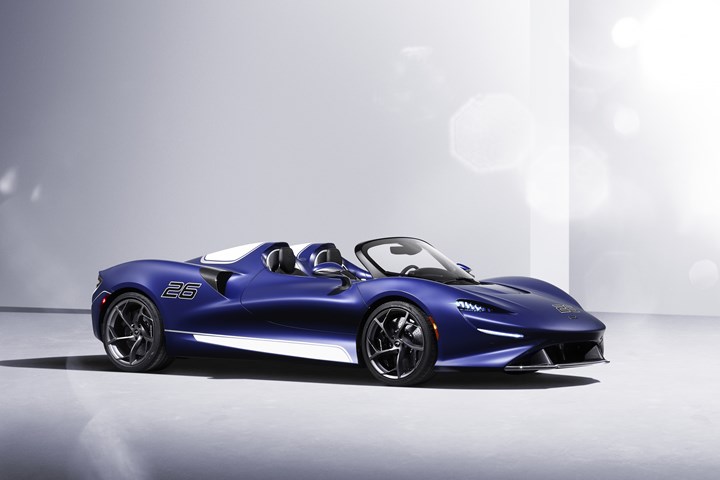
A slightly different version of the McLaren Elva. (Image: McLaren Automobiles)
Quick: Look at that picture of the McLaren Elva and ID what’s unusual about it.
And the clock starts. . .now.
No, it isn’t that it doesn’t have a roof (which it doesn’t)
Yes, it is that it has a windshield.
“Wait!” you object. “Windshields aren’t unusual.”
Yes, for the Elva it is.
When the roadster was developed, the engineers came up with what is called the “Active Air Management System” (AAMS).
AAMS Explained. The system consists of a large central air vent above the splitter, a front clamshell outlet vent and a carbon fiber deflector that rises 5.9 inches to activate the AAMS and lowers when not in use.
Within the outlet are a series of transverse and longitudinally mounted carbon fiber vanes.
In operation, the airflow is guided up and over the cockpit, creating a “bubble” that the vehicle occupants are within.
No windshield necessary. (There also aren’t any side windows.)
However. . .
Some people want a windshield. And some regulations make a windshield mandatory.
So McLaren Automotive is building versions of the Elva with a windshield. No AAMS.
One of the characteristics of the Elva is that it is light. The vehicle (sans screen) has a dry weight (i.e., no fluids) of under 2,866 pounds.
So the windshield system for the car—the heated glass with a carbon fiber surround, electronically synchronized rain-sensing wipers, washer jets, and sun visors—add only 44 pounds of mass.
Yes, the car can go from 0 to 62 mph in 2.8 seconds.
///
Lambo Countach at 50
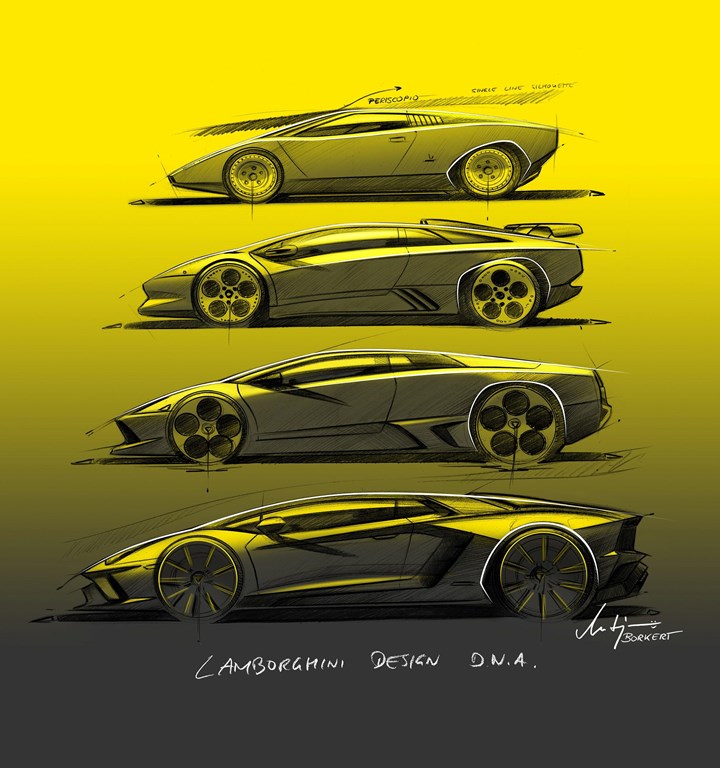
This is what “evolution” means. (Image: Lamborghini)
There are works of art that always remain relevant, and the form of the Countach is one of them. Its design is comprised of perfect proportions, characterized by a very pure and essential approach. Its distinctive feature is the single longitudinal line that visually connects the front and rear parts. From a stylistic point of view, it’s a perfect inspiration because, even when the rest is modified, the line is an element of visual continuity between past and present. It’s the epitome of the DNA in all Lamborghini design, the tradition of the stylistic language from the origins to the present day.”-- Mitja Borkert, Head of Design at Lamborghini
///
A View You Otherwise Won’t Get. . .
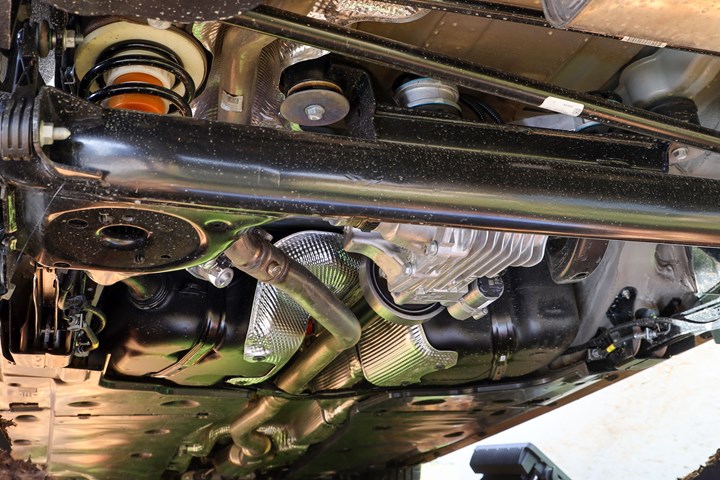
Under the Caddy. (Image: Volkswagen Commercial Vehicles)
. . .unless you’re working the assembly line or work at a European auto service center.
It is the rear underpinnings of the fifth-generation Volkswagen Caddy, the company’s commercial van.
The new design features a Panhard rod guided by trailing arms. Coil springs are used in place of the previous generation’s leaf springs.
So why is this important?
Space savings without sacrificing comfort or capability.
The entire package—the top and bottom trailing arms, shocks, axle tube, coil springs, Panhard rod—take minimal space. This allows wider load capacity inside the van. The space between the wheel arches is 1.23 meters, so euro pallets (1,200 x 800 x 144 mm) can be fitted in sideways.
There is room for the integration of the differential for vehicles with the all-wheel-drive 4MOTION system.
There is also room for installing CNG tanks for the late-launch natural gas variant.
///
A Rolls Not for the Rest of Us
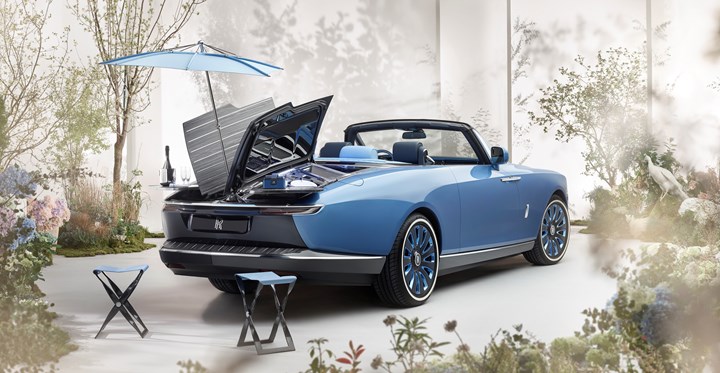
Of course: a picnic with a Rolls (Image: Rolls-Royce)
Yes, that is a real Rolls-Royce.
The Boat Tail.
Yes, those two pieces on a diagonal (15° each) are, in keeping with a nautical theme, wood. Caleidolegno veneer, the same type of wood used on the interior.
And yes, that umbrella—or “parasol” in Rolls parlance—is part of the accessories (as are a refrigerator, specific cutlery, etc.).
But here’s an interesting product development aspect of this car. Of which three are built for clients of Roll-Royce Coachbuild:
- The vehicle was originally hand drawn. A full-size clay was created. The clay was scanned and a buck was produced. The buck is the form that craftspeople use to hammer-form the aluminum body panels. Not stamped body panels. Hammered.
That is seemingly unreal.
///
2021 Buick Envision Essence AWD
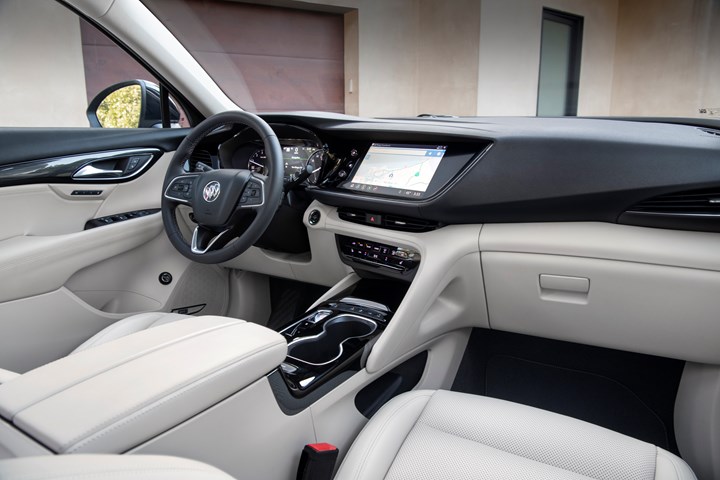
The impressive Envision interior. (Image: Buick)
The folks at Buick certainly know what’s going on in the market. Once a purveyor of large, comfortable sedans, the team there recognized that when it comes to large, comfortable sedans, there is little in the way of a market. In the GM hierarchy there was Chevrolet below it with the Impala on offer, and that went away. And above it Cadillac had the CT6 and that has departed the dealerships, too.
So Buick has gone all SUV, with the Enclave at the top, then the Encore GX and Encore at the bottom.
(I would delete the Encore from the offering because it is too small and consequently ill-proportioned to be an authentic Buick. That is, it is 168.4 inches long, 70.1 inches wide and 65.2 inches high, which leads to an overall shape that appears awkward. The Encore GX, which is a well-executed compact SUV, measures 171.4 inches long, 71.4 inches wide and 64.1 inches high, which leads to far better proportions. Let Chevy sell its version of the Encore, the Trax.)
But this is about the other entry, the Envision.
Shhh. . . . It is a five-passenger compact crossover that is contemporary and comfortable. Note well: the comfort comes from the nicely quilted leather seats, not from a suspension that wallows. It has a MacPherson strut front suspension and five-link independent rear suspension, which seem to be tuned to be coordinate with the “QuietTuning” that is part of the audio experience (active noise cancellation and strategically placed materials): not stiff and not soft. Dare I say “just right”?
Sculptural. Although the exterior sheet metal for this second-generation Envision is fresh, the standout styling is on the interior of the vehicle, where there are layered and kinetic shapes that create the instrument panel and move into the door panels. The Essence trim, the middle choice between Preferred and Avenir, has a standard 10.2-inch screen, which is, again, the right size: no need to squint; no need to think that someone superglued an iPad on the IP.
Sufficient. One thing that was OK is the powertrain. Yes, just OK. The Envision—across the board—has a 228-hp 2.0-liter turbocharged I4 engine mated to a nine-speed automatic. The AWD model that I drove has a curb weight of 3,904 pounds. Which is a lot of mass to be moved.
Take a deep breath. A standard feature on the Essence and Avenir models is an air ionizer with an “air quality indicator.” According to Buick, “Research shows Americans spend approximately 10 hours a week in the car.”
According to the TomTom Traffic Index, the U.S. has one city in the top 100 most-congested (LA). China has six cities in that ranking. Which is to say that the air ionizer probably is more important there. And to note that the Envision is produced by SAIC-GM Dong Yue Motors Co., Ltd, in Yantai, Shandong, China.
Where it is built doesn’t really matter. But you should know.
RELATED CONTENT
-
GM Develops a New Electrical Platform
GM engineers create a better electrical architecture that can handle the ever-increasing needs of vehicle systems
-
The Koenigsegg Jesko Has An Amazing Engine
It is hard to believe that this is a vehicle in “serial” production with such extraordinary powertrain performance
-
Multiple Choices for Light, High-Performance Chassis
How carbon fiber is utilized is as different as the vehicles on which it is used. From full carbon tubs to partial panels to welded steel tube sandwich structures, the only limitation is imagination.


.jpg;width=70;height=70;mode=crop)






